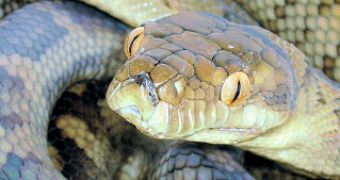The classical number of cobra dancing is a spoof. Even if the snakes would be tamed so that they would dance to the sound of the music, they could not do it. They just follow the tamer's continuous movements of the arms and knees, while he's playing a wind instrument, as snakes don't even hear the music; snakes detect just sounds with frequencies of 100-500 Hz, and they perceive only ground vibrations through the bones of the lower jaw.
They lack the outer ear and the middle ear with its bones, and this caused the myth that they can't hear at all. But they do posses complete inner ear systems, including functional cochlea (the fluid-filled structure containing hearing sensors), fully connected to and stimulated by their lower jaw.
Now, a team from the Munich University in Germany and the University of Topeka, Kansas have found some amazing details of how snakes can hear through their jaws, described in their research published in Physical Review Letters. In a geometric research of the anatomy of horned desert vipers, the team focused on how the snake detects ground waves created by the footfalls of their prey. Mathematical models showed that jaw-to-cochlea system is sensitive to the frequencies of the prey's ground vibrations, like the tiny vibrations made by scampering rodents or other small animals.
Surprisingly (or not?), the snakes' amazing ability to unhinge their jaws and swallow their whole prey enables them to receive vibrations independently from the right and left side of their jaws: this is stereo hearing! The stereo hearing enables the snakes to create a map of the environment. Some experiments had shown that some snake species can catch their prey using only the vibrations of the ground. The stereo hearing means that the shaking of the rattle of the rattlesnake is, in fact, two times intenser for the snakes themselves...
This study clearly shows that ground vibrations to the lower jaw are a much more significant source of sensory input for the crawling reptiles than previously believed. It's like watching with your ear (or jaw?).

 14 DAY TRIAL //
14 DAY TRIAL //